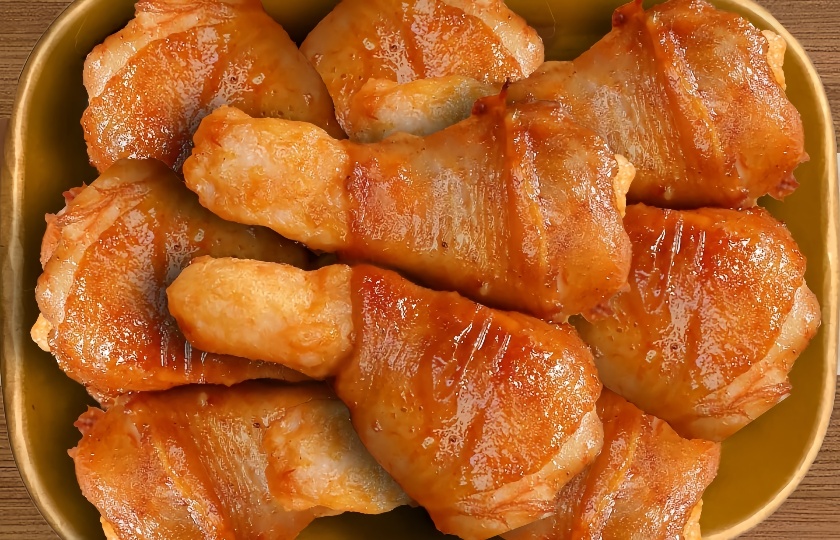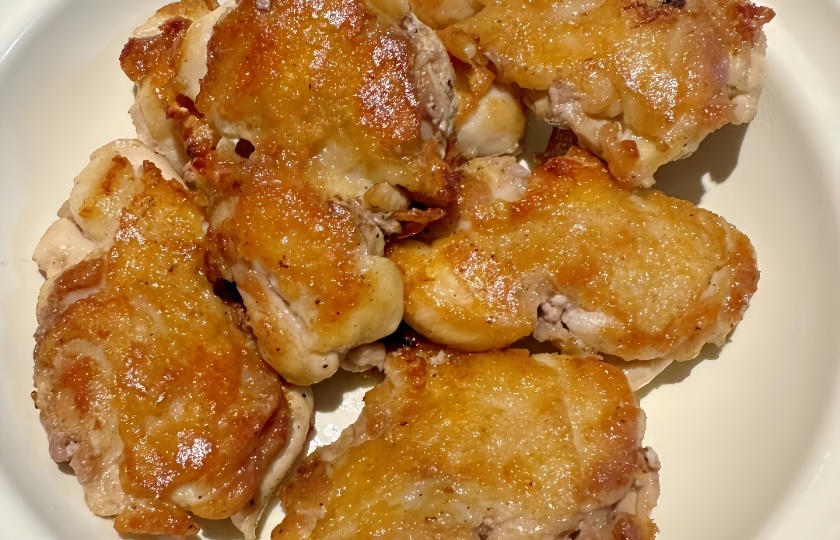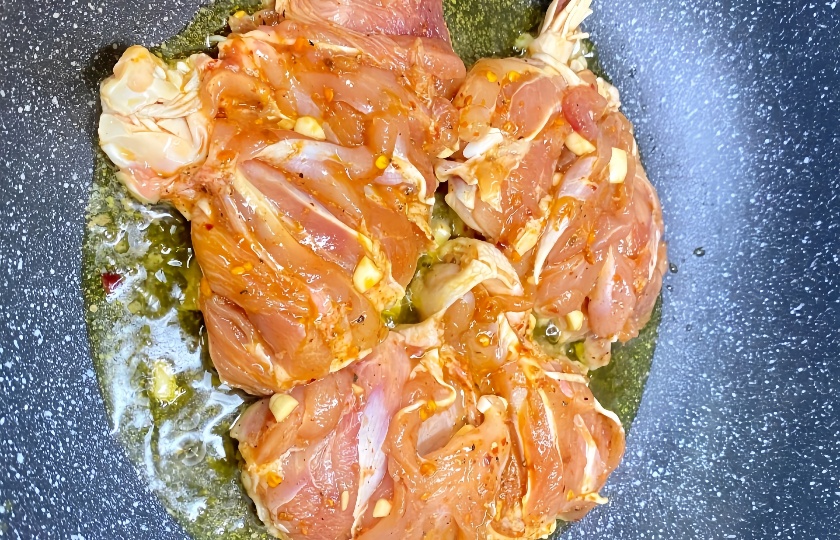Treats Guide: How Long to Cook Boneless Chicken Thighs on Stove?
 Boneless chicken thighs are super convenient, but many people don't know how long to cook them on the stove. The cooking time is crucial—undercooked chicken can cause stomach issues, while overcooked chicken can be tough and dry. Don't worry, today I'm sharing the ultimate guide to cooking boneless chicken thighs of different sizes on the stove, so you can easily achieve perfectly cooked chicken every time!
Boneless chicken thighs are super convenient, but many people don't know how long to cook them on the stove. The cooking time is crucial—undercooked chicken can cause stomach issues, while overcooked chicken can be tough and dry. Don't worry, today I'm sharing the ultimate guide to cooking boneless chicken thighs of different sizes on the stove, so you can easily achieve perfectly cooked chicken every time!
How long to cook boneless chicken thighs on the stove?
Cooking Times for Boneless Chicken Thighs on the Stove
The cooking time for boneless chicken thighs varies depending on their size and the heat level of your stove. Here’s a general guide:
Medium-sized thighs (5-7 oz each): Cook over medium-low heat for about 15-20 minutes. The meat is relatively thick and needs enough time to cook through. If you use high heat, you can shorten the cooking time to 10-15 minutes, but be sure to turn them frequently to ensure even cooking.
Smaller thighs (around 3.5 oz each): Cook for 10-15 minutes on medium-low heat.
Larger thighs (over 7 oz each): May require 20-25 minutes or more.
How to Tell If They’re Done
Juice Test: Insert a fork or skewer into the thickest part of the thigh. If the juices run clear and there’s no pink, the chicken is done.
Thermometer Test: Use a kitchen thermometer to check the internal temperature. It should read 165°F (75°C) or higher.
Tips for Flavorful Chicken Thighs
Marinate: Marinating the chicken in soy sauce, garlic, ginger, and pepper for 30 minutes to an hour can enhance the flavor.
Make a Broth: Add vegetables like carrots, onions, and celery while cooking for a delicious broth that complements the chicken.
Sear and Simmer: For a crispy exterior, sear the thighs in a little oil until golden brown, then add water and simmer until cooked through.
With these tips, you’ll have perfectly cooked boneless chicken thighs that are juicy and flavorful. Enjoy your cooking!How to Cook Boneless Chicken Thighs in a Skillet?
Cooking Boneless Chicken Thighs in a Skillet: Easy Steps to Follow
Preparation:
Ingredients and Seasonings: Prepare boneless chicken thighs, salt, black pepper, soy sauce, cooking wine, garlic, and ginger. You can also have some honey on hand if you like.
Chicken Thigh Preparation: Clean the boneless chicken thighs and pat them dry with paper towels to avoid oil splatter during cooking. Make a few shallow cuts on both sides of the chicken thighs to help the flavors penetrate. Place the chicken thighs in a bowl and add salt, black pepper, soy sauce, cooking wine, minced garlic, and minced ginger. Mix well and let it marinate for 15-20 minutes.
Cooking Process:
Heat the Skillet: Place a skillet on the stove over medium heat. Add a suitable amount of oil, such as olive oil or corn oil, and swirl the skillet to coat the bottom evenly.
Cook the Chicken: Once the oil is slightly heated, place the marinated chicken thighs in the skillet, skin-side down or the thicker side first. Cook for 2-3 minutes until the surface turns golden brown. Carefully flip the chicken using tongs or a spatula and cook the other side for another 2-3 minutes until it also turns golden brown.
Ensure Doneness and Add Flavor:
Check for Doneness: Insert a chopstick or a skewer into the thickest part of the chicken thigh. If the juices run clear and there's no blood, the chicken is cooked through. If unsure, you can cook it on low heat for a bit longer.
Enhance Flavor (Optional): If you prefer a sweet glaze, brush a layer of honey on both sides of the chicken thighs after they are fully cooked. Sear them briefly to create a caramelized finish, adding shine and depth to the flavor.
Following these steps, you can easily make delicious boneless chicken thighs in a skillet!
How to Cook Boneless Chicken Thighs in a Skillet?
Cooking Boneless Chicken Thighs in a Skillet: Easy Steps to Follow
Preparation:
Ingredients and Seasonings: Prepare boneless chicken thighs, salt, black pepper, soy sauce, cooking wine, garlic, and ginger. You can also have some honey on hand if you like.
Chicken Thigh Preparation: Clean the boneless chicken thighs and pat them dry with paper towels to avoid oil splatter during cooking. Make a few shallow cuts on both sides of the chicken thighs to help the flavors penetrate. Place the chicken thighs in a bowl and add salt, black pepper, soy sauce, cooking wine, minced garlic, and minced ginger. Mix well and let it marinate for 15-20 minutes.
Cooking Process:
Heat the Skillet: Place a skillet on the stove over medium heat. Add a suitable amount of oil, such as olive oil or corn oil, and swirl the skillet to coat the bottom evenly.
Cook the Chicken: Once the oil is slightly heated, place the marinated chicken thighs in the skillet, skin-side down or the thicker side first. Cook for 2-3 minutes until the surface turns golden brown. Carefully flip the chicken using tongs or a spatula and cook the other side for another 2-3 minutes until it also turns golden brown.
Ensure Doneness and Add Flavor:
Check for Doneness: Insert a chopstick or a skewer into the thickest part of the chicken thigh. If the juices run clear and there's no blood, the chicken is cooked through. If unsure, you can cook it on low heat for a bit longer.
Enhance Flavor (Optional): If you prefer a sweet glaze, brush a layer of honey on both sides of the chicken thighs after they are fully cooked. Sear them briefly to create a caramelized finish, adding shine and depth to the flavor.
Following these steps, you can easily make delicious boneless chicken thighs in a skillet!
What’s the Best Pan for Cooking Chicken Thighs?
Cast Iron Skillet
Pros: Thick and heavy, it retains heat well, providing stable temperatures for even cooking and a beautiful sear. Perfect for getting crispy skin on boneless chicken thighs without burning the outside or undercooking the inside. Its non-stick properties improve with use, making cleaning easier as a natural oil layer develops over time.
Cons: Heavy and can be difficult to handle if you’re not strong. Needs proper care to avoid rust, such as drying thoroughly after washing.
Stainless Steel Pan
Pros: Durable and resistant to scratches and rust. Can withstand high heat, making it great for achieving crispy skin. Easy to clean with dish soap and a sponge.
Cons: Heats up quickly, which can make temperature control challenging. Chicken thighs may burn on the outside while remaining undercooked inside if the heat is too high. Less non-stick than cast iron or non-stick pans, potentially requiring more oil.
Non-Stick Pan
Pros: Excellent non-stick capabilities, allowing you to use less oil without sticking or tearing the skin, making it very beginner-friendly.
Cons: The coating is delicate and can’t withstand metal utensils like spatulas, which can damage it. Shorter lifespan as the non-stick surface degrades over time.
In summary, beginners might prefer a non-stick pan for ease of use. For crispy skin and long-term use, a cast iron skillet is ideal. If durability and easy cleaning are your priorities, a stainless steel pan is a good choice.
Is It Better to Cook Chicken Thighs in the Oven or on the Stove?
Choosing between the oven and the stove for cooking chicken thighs depends on your cooking preferences and the texture you’re aiming for. Here are the features of each method to help you decide:
Oven Cooking
Even Heating: The oven provides consistent heat, ensuring that every part of the chicken thigh cooks evenly. This results in tender meat with a crispy skin.
Easy Control: With precise temperature settings, the oven allows you to adjust the heat and time according to different recipes, making it ideal for slow roasting.
Less Smoke: Compared to stove cooking, the oven produces less smoke, making it a healthier option.
Stove Cooking
Quick Heating: The stove heats the pan and chicken quickly, perfect for fast cooking.
High Flexibility: You can easily adjust the heat based on the chicken’s color and aroma, offering more control.
Traditional Method: Many people find stove cooking more familiar and comforting.
Cooking Tips
If you want crispy skin and juicy meat, the oven might be the better choice.
If you need to cook quickly or prefer a traditional method, the stove is more suitable.

Can You Overcook Boneless Chicken Thighs?
Control the Time: Generally, cooking for 10-15 minutes should be sufficient, but adjust based on the size and thickness of the thighs.
Use a Thermometer: Check the internal temperature of the chicken. It should reach 165°F (74°C) for safety.
Check for Doneness: Insert a fork or knife gently. If it goes in easily and no pink juices run out, the chicken is done.
Let It Rest: After cooking, let the chicken rest for a few minutes. This helps the flavors meld and keeps the meat tender and juicy.
By following these tips, you’ll ensure your boneless chicken thighs are perfectly cooked and delicious. Give it a try!
Should Chicken Thighs Be Cooked Fast or Slow?
First, let's clarify what you’re looking for! Do you want a quick and tasty meal, or are you aiming for that melt-in-your-mouth tenderness?
Quick Cooking
If you choose quick cooking, it’s definitely time-saving and effortless!
Pros: Short cooking time, retains more nutrients, crispy skin while keeping the inside juicy.
Methods: Start by pan-searing or roasting to get crispy skin, then quickly cook or steam. You can also use a pressure cooker for convenience!
Slow Cooking
If you prefer a melt-in-your-mouth experience, go for slow cooking!
Pros: More evenly cooked, rich flavor, and a more complex texture. Perfect for larger cuts, keeping the meat tender.
Methods: Use a slow cooker or low-temperature oven to let the chicken absorb the flavors of the broth and seasonings.
My Suggestion
Both quick and slow cooking have their merits. It really depends on your taste and needs!
If you’re busy and need something fast, go for quick cooking.
If you love rich flavors and tender textures, opt for slow cooking.
Ultimately, no matter which method you choose, the most important thing is to enjoy the cooking process and the delicious results!























